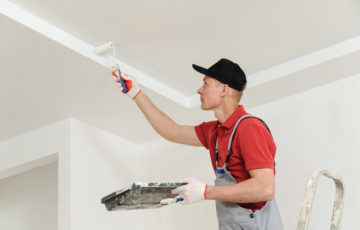Commercial painting projects are large undertakings that usually pay very well. However, all professional painters know that sometimes a big job can become a bit challenging. Before you know it, your painting gig is going sideways and you’re not sure what to do next. It’s best to get ahead of this situation from the start so you don’t have issues later. Take a few minutes to read through our tips to make your commercial projects profitable and successful.
You may also want to think about getting painters public liability insurance too. This is something easy and affordable that you can do to protect you, your employees, and your painting business. In case your commercial client isn’t so thrilled with your performance, you’ll be glad to have public liability coverage. This type of insurance will help your company from absorbing financial damages and legal fees associated with negligence, including property damages and personal injuries.
Our top eight pro tips for keeping your commercial painting jobs headed in the right direction are below. Read on for some great ideas.
Double Check Bidding: The first step to making sure you can adequately manage a large-scale endeavor is having an accurate bid. It seems obvious but painting contractors do occasionally send out bids without double checking their figures. That means sometimes errors in scope and pricing can be proposed to the client. This will set you up from failure before you even buy a new paintbrush.
It’s critical that you make multiple visits to the potential job site, rework your numbers several times, and have a business partner or supervisor check your bid for any errors or omissions.
2. Taking the Job: If you win a job bid, that doesn’t mean you have to complete the deal. Perhaps you talk with the potential client and realize that the job may not be a good prospect after all. You certainly have the choice to decline the work. In fact, it might be a situation where you’ll lose money or miss out on a better opportunity by accepting this gig. You should be honest with the customer about your reasons for not taking their commercial painting project. Don’t take the job unless it’s going to benefit your business.
3. Perfect Your Planning: A big commercial painting job may take a few weeks of organisation before you can even put down your drop cloths. It’s best to talk with your supervisors and your painting crew. You want to go over all the specs of the job, present what your client’s expectations are, and decide the best plan of attack. It’s important to anticipate any challenges that could arise and have a Plan B (or even a Plan C) to keep things moving along despite any snags.
4. Walk the Job Site: Go out to your job site with your lead painter or field manager and walk around the job site. You can all work together to develop the best plan for completing the project on budget and on time. You’ll also want to answer any questions your team has about the painting project. This is a necessary step to avoid any confusion later among our painting crew.
5. Good Oversite: Big painting jobs can be broken down by task, building, or spaces. You can include timelines and estimated costs for each of the individual assignments. Throughout the entire process, you’ll want to job cost to make sure you’re still on track and meeting the customer’s expectations. Breaking down a big project into bite size, manageable pieces is a sign of good leadership. Your painting crew will work more efficiently as a result.
6. Track Material Costs: As you know, material costs should be 15-20% of the job. The original bid included an estimate of material costs. It’s up to you and your management team to continually update how much money is being spent. You want to keep good control over the material costs. If you don’t check-in periodically, then the pricing could quickly get away from you.
7. Change Orders: You’ll want to keep a close watch on any change orders. This is when you must alter the original bid and suggest additional work to be done. You know what that means, asking your client for more time and more money. It’s best to avoid change orders whenever you can.
Unfortunately, there will be times you have to power wash or remove rotten ceilings that weren’t anticipated. Be sure to notify your customer, have them sign the change order, and keep that in your project files.
8. Communication Is Key: It sounds silly, but communication is maybe the most important way to keep a commercial painting project in line with the plan. Your painting crew may discover problems with the paint or the surface. You may have challenges with personnel or with the client. To keep things under control, it’s a good idea to keep everyone in the loop as to what’s going on and what to expect. Better to over communicate than leave your employees and clients confused.
Once and a while big painting jobs will seem overwhelming, but if you follow our advice, you’ll be okay. Should you get nothing out of this article, at the very least be sure you have a good painters public liability policy. That way no matter if your commercial job is done to spec or not, you’ll know your business is protected.


